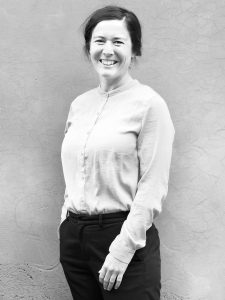Nadja Bournonville

Shortbio
- born 1983, Vimmerby, Sweden
- working as a freelance artist since 2007
- 2022 recipient of Neustart Kultur scholarship for a journey set in the trails of Mary Wollstonecraft’s book “Letters Written During a Short Residence in Sweden, Norway, and Denmark, 1795”
- 2021 Swedish Photobook award for “A worm crossed the street”
- 2021 Berlin Senat Research Grant
- 2019 Stiftung Kunstfonds Publication Grant
- 2017–2018 Recommended Fellowship for the project “Intercepted”
- 2014 Stiftung Kunstfond one year working Grant
- 2010–2012 “A conversion act” MA at the Academy of Visual Arts, Leipzig, Prof. Tina Bara
- 2003–2006 Ba(Hons) First Class Degree in Fine Art Photography, The Glasgow School of Art, Glasgow UK
Contact
Bauhaus-Universität Weimar
Fakultät Architektur und Urbanistik
DFG-Graduiertenkolleg 2227 „Identität und Erbe“
D-99421 Weimar
Sitz: Prellerhaus | 3. OG | Raum 303
Geschwister-Scholl-Str. 6 | D-99423 Weimar
nadja.bournonville[at]uni-weimar.de
Housing disappearance and preservation – on the cultural heritage of natural history collections
Millions of animals slumber in natural history museums all over the world, as dry or wet specimens they lead an existence on shelves and in cabinets, in cellars, attics and partly also in permanent exhibitions. Some of these specimens are several hundred years old. On the one hand, witnesses of the thirst for knowledge, the passion for collecting, the will to classify and the developing art of taxidermy. On the other hand, an image of the dreams, curiosity and projection of their dangerous counterpart, us humans. While the collections of natural science institutions become more extensive, gaps in the original habitats emerge. Centering around the animal specimens, this dissertation project aim to highlight the role, materiality and esthetics of the natural history collections in times of declining biodiversity and digitalization. Based on my artistic practice and through case studies, I will explore this cultural heritage and investigate its contemporary relevance.
”To make an exact image is to insure against disappearance, to cannibalize life until it is safely and permanently a specular image, a ghost”1
As an artist, I was able to photograph in the scientific collections of the Museum of Natural History in Vienna over an extended period of time, an activity which lured me into the museum. Photography in particular plays a curious role in relation to loss and an estetics of disappearance. In its effort to ward off time, it is related to taxidermy. Exploring the analogy between these two practices is an essential part of the dissertation. Roland Barthes’ famous concept of the punctum refers to a moment that existed, that was tangible, and hurled into the present through photography. The medium thus develops a certain resistance to loss, although simulanteously it contains the possibility of overwriting and replacement. Here, as with taxidermy, the question of emerging voids and discrepancies arise.
The digitalization of collections can bring forward forgotten knowledge, produce new content and facilitate worldwide access without an actual encounter with a site-specific, fragile specimen. Through the digital image, even the availability of a real reference is no longer imperative. Natural history collections are becoming increasingly digitalized. Photography, film and animated images are replacing the taxidermied animals in the exhibition halls. Do the animal specimens still have something important to tell us? The taxidermied animals in the natural history collections are by all means talkative. Materiality, provenance, traces of violence, transport routes and processing in the collection, but also information about perception of time and aesthetics, errors, gaps, fantasy and thus social themes are inherent in their very existence. The animal specimens remind of the elusive smile of the Cheshire Cat from Alice in Wonderland, shadows of their living counterparts or echoes of lost species such as the Great Auk. At times, they demonstrate our will to shape nature to our desires, such as the Viennese Basilisk at the Museum of Natural History in Vienna. This specimen is supposed to represent the basilisk, a mythological creature, but in fact it consists of a ray, whose genitals have been turned into legs, and whose mouth has been shaped into a snout. It kept hidden in the collection until the nineties, was damaged by parasites, then preserved in alcohol and currently presented in the permanent exhibition.2 It embodies a mythical figure while simultaneously telling a story of taxidermy, economics, art, and serendipity. Even the existing specimens of extinct or endangered species are in a way fictional beings. The fate of the Great Auk is an eerie example of an act of preservation and loss. This bird was so sought after as a collectible item that even the last two specimens were killed and sold to museums. During a case study, I intend to examine several of these available specimens and conduct interviews with museum staff and taxidermists on the occurrence of the Great Auk in natural history collections. In so doing, the role and physicality of taxidermy in preserving the echo of a lost species will be examined. The process of disappearance is irreversible. Conservation, records, or digital revival cannot halt this process, but merely accompany it and follow it’s traces, through a house of disappearance and preservation.
1. Haraway, Donna „Teddy Bear Patriarchy: Taxidermy in the Garden of Eden, New York City, 1908–1936”, 1984
2. Riedel, Bettina „Science Talks”, Naturhistorisches Museum Wien, 2021
Current Publications
2020 ‘A worm crossed the street’, Fotohof edition
2018 ‘Intercepted’, Fotohof edition
2017 ‘Blindfell’, self published poster edition
2012 ‘A Conversion Act’, Fotohof edition
2010 ‘To be undone’, Galerie Gabriel Rolt
2009 ‘Amor Omnia Vincit’, Pierogi Gallery
2008 ‘One for every wish’, Pierogi Gallery